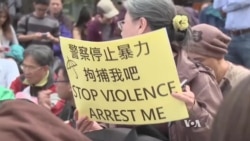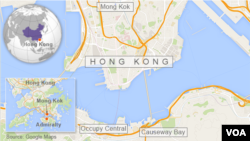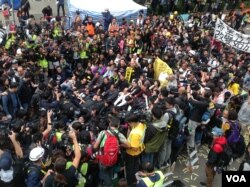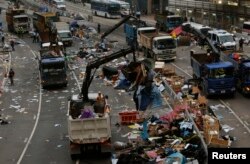Authorities in Hong Kong removed barricades and encampments from streets outside government offices in the port city, drawing to a close more than two months of pro-democracy protests.
Before ending the largest protests the Chinese government has seen in more than two decades, authorities had voiced concerns about possible violence. That did not happen.
However, groups of up to four police arrested holdout protesters one by one, hours after workers used wire cutters to remove barricades and dismantle art installations.
As they felled a large bamboo scaffolding, the message on a banner strung across the monstrosity was telling: “Its just the beginning,” it read.
At the protest site, authorities used about 20 large trucks with cranes to remove mountains of rubbish. By late evening, traffic had resumed along two lanes of the previously blocked highway.
To clear the area, police enforced a High Court ruling that allows authorities to reopen traffic in Admiralty. Similar action is expected soon at a smaller site in Causeway Bay.
The exact number of those detained is not immediately clear. But The Associated Press reported that police said they had arrested more than 200 people, most for unlawful assembly and obstructing police officers.
Activists arrested
Among those police took away were pro-democracy media mogul Jimmy Lai, pop singer Denise Ho, veteran pro-democracy activist Martin Lee and pro-democracy legislators including Albert Ho. Leaders from the Hong Kong Federation of Students and Scholarism, two student groups that have played key roles in organizing the protests, were also taken to police stations.
Before his arrest, Lee told VOA that Hong Kong officials were to blame for the protests.
"The government of [of Hong Kong] should have stood up for us, but it has been standing on the Central Government’s side, acting like a turtle with its head inside its shell, asking the students to go home," Lee said.
"It is now not even willing to talk. It forces us out here. But we are all responsible for our own actions. Look at these young people. They are ready to sacrifice for their own future, for the future of their next generation," he added.
Ethan Chun, a leader of the Hong Kong Federation of Students said protesters will be out again if authorities continue to ignore their demands.
“We’ve already awakened a society. I think that even though the police and government can clear the street, but they cannot clear and get away with a whole population who are awakened,” Chun said.
Another student named June agreed.
“I believe one thing is that the history will prove that we are right," she said.
Public disapproval
At its peak, the so-called Occupy protest movement attracted tens of thousands of demonstrators, presenting an unprecedented challenge to Beijing's rule of Hong Kong.
But Hong Kong residents have grown increasingly tired of the street protests, which have blocked major thruways in the busy city and impacted businesses.
However, public disapproval of the methods protesters have used does not necessarily equal opposition to what they are fighting for - the right to select and elect their top leader without any interference from Beijing.
Despite weeks of protests, China has shown no signs that it is willing to make any compromises. And while most Chinese state media commentaries have written the movement off as temporary, arguing that student protesters are being manipulated by foreign powers, it is clear Chinese authorities are concerned.
Dozens have been detained here just for voicing their support for the movement. An editorial this week in the Global Times, which is owned by the Communist Party’s People’s Daily asked: How Far is the Color Revolution From China?
The piece quoted Rear Admiral Yang Yi from the PLA National Defense University as warning that the risk posed from Occupy Central should not be taken lightly. He also argued that the next step in addressing the problem was to hold “trouble-makers” responsible and make rules so that such protests do not happen again.
What's next?
The next big milestone for the movement will be when Hong Kong lawmakers vote on the controversial election plan next year that China has told the port city it must accept. That proposal says Hong Kong residents can vote to elect their next chief, but requires candidates be approved by a pro-Beijing committee.
“During that time I think we will all be out again," said Liana, a student protester.
So for now, Hong Kong is seeing an end to one chapter, but the beginning of the next.
Some material for this report came from Reuters and AP.











